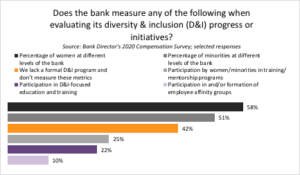
What is Your Bank Measuring?
Recent comments around diversity from Wells Fargo & Co.’s CEO brought renewed attention and focus on a problem that continues to plague corporations, including banks.
In a video call with staff over the summer, Charles Scharf pointed to a “limited pool of Black talent” as the reason why the bank missed its diversity and inclusion (D&I) targets.
Scharf has since walked back those comments. “There are many talented diverse individuals working at Wells Fargo and throughout the financial services industry, and I never meant to imply otherwise,” he told employees. “I’ve worked in the financial services industry for many years, and it’s clear to me that, across the industry, we have not done enough to improve diversity, especially at senior leadership levels.”
Wells Fargo, it should be noted, has established clear D&I goals. It expands on these in a recent press release: Diverse candidates must be considered for key roles, and the bank plans to integrate D&I into business plans and reviews. An anti-racism training course is under development. And the achievement of D&I goals will directly impact executive compensation decisions.
Most banks lack that level of commitment: 42% don’t have a formal D&I program, according to Bank Director’s 2020 Compensation Survey.

Rockland, Massachusetts-based Independent Bank Corp. details its “Inclusion Journey” for 2020 through a nine-page document that’s posted on its website. For the $13 billion holding company, which operates Rockland Trust Co., this includes conducting an assessment to identify strengths and weaknesses throughout the organization, and establishing a D&I council co-chaired by senior vice president and Director of Human Resources Maria Harris.
“We have a responsibility to create an environment where respect, understanding and innovation are at our core,” says Harris. “Every colleague is critical to our growth as a company, and we are committed to a culture of teamwork, inclusion and employee engagement.”
Resource groups build awareness and address the needs of female and LGBTQ employees. In response to current events, the bank has offered webinars on self-care during the Covid-19 pandemic and conducting open discussions on racism. “These have been very beneficial for folks to better understand systemic racism and how to become an ally,” explains Harris. All new employees receive D&I training, which focuses on unconscious bias and related behaviors.
Just 22% of survey respondents say their bank tracks participation in D&I focused training; even fewer – 10% – measure employee resource group participation and formation.
Rockland Trust tracks applicants, hires, transfers, promotions and terminations, says Harris. It also measures employee tenure, participation in professional development programs and conducts exit interviews. All of this data informs the bank’s D&I goals.
“Our current initiative to advance front-line professionals of color was created to address findings from our data, which demonstrated that although minorities were participating in our internal career pathing program, they were not advancing at the same rate,” she explains. “We wanted to proactively change that within our organization.”
For many companies, focusing on D&I helps strengthen the culture, while attracting talented employees who will ensure its success.
That requires leadership.
“Trying to lead an organization without taking measurements is like trying to coach a football game without yard markers,” wrote Ritz-Carlton founder Horst Schulze in his book “Excellence Wins: A No-Nonsense Guide to Becoming the Best in a World of Compromise.”
Bank Director’s 2020 Governance Best Practices Survey reveals that too many directors – 48% – don’t fully buy into the idea that diversity on the board has a positive effect on corporate performance. Connecting the dots, one can assume that they don’t place a lot of value on building an effective D&I program within their bank, either.



